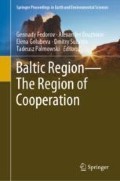Abstract
In connecting people’s expectances and reality, border crossing has certainly a considerable impact on human behavior and mind, especially in case if this act becomes an individual’s regular practice and/or a mean of existence. In this case, borderland can be transformed into a space of everyday interactions between the people and radically changes their life. The authors try to summarize the definitions of everyday life and theoretical approaches to its study used by different experts. The hypothesis is that everyday practice does not simply show distinctions or similarities of the people living close to the boundary on its both sides but allows understanding the shaping of different socio-cultural spaces and the differentiation of border regions as a whole. The authors estimate the opportunities and constraints created by the boundary and motivating its crossing, analyze its reasons and directions at all sections of Russian land borders. They focus on the socio-economic and socio-cultural discrepancies, and the features of neighbouring areas stimulating specific practices distinguishing borderlands from the rest of the state territory.
Access this chapter
Tax calculation will be finalised at checkout
Purchases are for personal use only
Notes
- 1.
According to the Head of the Department of International Relations and Border Cooperation of Belgorod oblast’, January 2016.
- 2.
Rambler finance (2008) Glava Primor’ya: chislo kitayskikh turistov v kraye uvelichilos’ v 2,5 raza (The head of Primorye: the number of Chinese tourists in the province increased by 2.5 times). finance.rambler.ru/news/1676585. Accessed 10 November 2017.
References
Brednikova OE (2008) Prigranich’e kak social’nyj fenomen (napravlenija sociologicheskoj konceptualizacii) (Borderland as a social phenomenon (directions of sociological conceptualization). Vestn Sankt-Peterbg Univ 12(4):492–497 (in Russ.)
Izotov A, Laine J (2012) Constructing (Un)familiarity: role of tourism in identity and region building at the Finnish-Russian border. Eur Plan Stud 21(1):93–111
Kolosov VA (2016) Transgranichnaja regionalizacija i frontal’erskie migracii: evropejskij opyt dlja Rossii? (Cross-border regionalization and frontal migration: european experience for Russia?). Reg issled 3(53):83–93 (in Russ.)
Mishchuk SN (2016) Rossijsko-kitajskoe sotrudnichestvo v sel’skom hozjajstve Dal’nego Vostoka Rossii (Russian-Chinese cooperation in the agriculture of the Russian Far East). Izvest RAN Ser Geogr 1:38–48 (in Russ.)
Razowski Ł (2017) Pół roku bez małego ruchu granicznego. Resort podsumowuje zyski i straty. In: Olsztyn Onet. http://olsztyn.onet.pl/pol-roku-bez-malego-ruchu-granicznego-resort-podsumowuje-zyski-i-straty/196zwdm. Accessed 20 Mar 2017
Ryzhova NP (2013) Jekonomicheskaja integracija prigranichnyh regionov (Economic integration of border regions). IJEI DVO RAN, Habarovsk (in Russ.)
Simutina NL, Ryzhova NP (2007) Jekonomicheskie i social’nye vzaimodejstvija na transgranichnom prostranstve Blagoveshhensk-Hjejhje (Economic and social interactions on the transborder area of Blagoveshchensk-Heihe). Vestn DVO RAN 5:130–144 (in Russ.)
Vendina OI, Kolosov VA (2007) Partnerstvo v obhod bar’erov (Partnership to bypass barriers). Rossija v global’noj politike 5(1):142–154 (in Russ.)
Acknowledgements
“This work was done under the state assignment of the Institute of Geography RAS (0148-2019-0008, АААА-А19-119022190170-1)”. The article was prepared with partial support of the Immanuel Kant Baltic Federal University, the Russian Academic Excellence Project (5-100).
Ethical Approval and Informed Consent All the procedures performed in the study conforms to ethical standards applicable to conducting this kind of research including fieldwork collection of sociological information (Commission Decision of the Institute of Geography, Russian Academy of Sciences on conformity of an empirical research project to ethical standards, No. 3 from April 1, 2014). Informed consent was verbally obtained from all individual participants (experts and informants) included in the study.
Author information
Authors and Affiliations
Corresponding author
Editor information
Editors and Affiliations
Rights and permissions
Copyright information
© 2020 Springer Nature Switzerland AG
About this paper
Cite this paper
Zotova, M.V., Gritsenko, A.A., Sebentsov, A.B. (2020). Everyday Life in the Russian Borderland. In: Fedorov, G., Druzhinin, A., Golubeva, E., Subetto, D., Palmowski, T. (eds) Baltic Region—The Region of Cooperation. Springer Proceedings in Earth and Environmental Sciences. Springer, Cham. https://doi.org/10.1007/978-3-030-14519-4_9
Download citation
DOI: https://doi.org/10.1007/978-3-030-14519-4_9
Published:
Publisher Name: Springer, Cham
Print ISBN: 978-3-030-14518-7
Online ISBN: 978-3-030-14519-4
eBook Packages: Earth and Environmental ScienceEarth and Environmental Science (R0)

